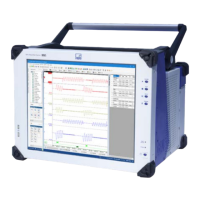GEN7iB
339
UNDERSTANDING INPUTS AND USAGE OF PROBES
UNDERSTANDING INPUTS AND USAGE OF PROBES15
15.2 GEN series voltage probe types
HBM offers a variety of probes. Which probe is needed depends on the application
and which instrument is being used. It is important to match the compensation of the
probe to the instrument.
● Passive, single-ended voltage probes
Theseprobescanbeusedwithsingle-endedordifferentialnon-isolatedampliers
andincreasetheinputrangeoftheamplieronlyinsingle-endedmode.Theytypi-
callydecreasetheoverallaccuracyoftheamplier.
● Passive, single-ended isolated voltage probes
Theseprobescanbeusedwithsingle-endedordifferentialisolatedampliersand
increasetheinputrangeofanisolatedamplieronlyinsingle-endedmode.They
typicallydecreasetheoverallaccuracyoftheamplier.
It is important to understand that they increase only the range, not the isolation
voltage.
● Passive, differential matched isolated voltage probes
Theseprobescanbeusedwithdifferentialisolatedampliersandincreasethe
inputrangeoftheamplierindifferentialmode.Theytypicallydecreasetheoverall
accuracyandtheCMRRoftheamplier.
Theyworkwithisolatedandnon-isolatedvariationsofdifferentialampliers.
Whenusedwithisolatedampliers,theyincreaseonlytherange,nottheisolation
voltage.
● Active differential voltage probes
Theseprobesareself-contained,differentialamplierstobeusedinfrontofan
instrumentusinganyamplierinsingle-endedmode.
The input range and accuracy depend on the type of active differential probe used
andhavenorelationtotheamplierused.Theyusuallyoperatefrombatteries;
this causes some inconvenience.
● Current clamps
Current clamps function more as transducers than probes, as they convert one
physical quantity (current) into another one (usually voltage). They are used to
perform non-invasive current measurements. This allows the current in a circuit to
be measured without disturbing the circuit.
There are other possibilities to measure current as well (current shunts, or Rogowski coils).

